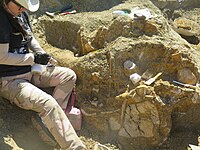| Chubutinectes Temporal range: Late Cretaceous (Upper Maastrichtian) PreꞒ Ꞓ O S D C P T J K Pg N ↓ | |
|---|---|
| Scientific classification | |
| Domain: | Eukaryota |
| Kingdom: | Animalia |
| Phylum: | Chordata |
| Class: | Reptilia |
| Superorder: | †Sauropterygia |
| Order: | †Plesiosauria |
| Family: | †Elasmosauridae |
| Clade: | †Weddellonectia |
| Genus: | †Chubutinectes O'Gorman et al., 2023 |
| Species: | †C. carmeloi |
| Binomial name | |
| †Chubutinectes carmeloi O'Gorman et al., 2023 | |
Chubutinectes (meaning "Chubut swimmer") is an extinct genus of elasmosaurid plesiosaur from the Late Cretaceous La Colonia Formation of Argentina. The genus contains a single species, C. carmeloi, known from a partial skeleton and associated gastroliths.
Discovery and naming

 Photographs from the excavation of the Chubutinectes type specimen
Photographs from the excavation of the Chubutinectes type specimen
The Chubutinectes holotype specimen, MPEF-PV 5232, was discovered in 2009 within sediments of the La Colonia Formation on the Somún Curá plateau in Chubut Province, Argentina. The disarticulated specimen consists of cervical, pectoral, dorsal, sacral, and caudal vertebral centra and neural arches, various ribs, partial pectoral and pelvic girdles, fore- and hind-limb elements, and about 350 gastroliths.
In 2023, O'Gorman et al. described Chubutinectes carmeloi as a new genus and species of elasmosaurid plesiosaur based on these fossil remains. The generic name, "Chubutinectes", combines a reference to the Argentinean province "Chubut", where the holotype was found, with the Greek word "nectes", meaning "swimmer". The specific name, "carmeloi", honors Carmelo Muñoz, the discoverer of the holotype.
Description
The holotype of Chubutinectes is an osteologically immature specimen with a dorsal region measuring 1.4 m (4.6 ft) long, indicating that it was larger than an adult Kawanectes from the same formation. This size difference may result from their environmental difference, as Kawanectes lived in estuaries, while Chubutinectes lived in marine habitats.
Classification
O'Gorman et al. (2023) recovered Chubutinectes as a member of the elasmosaurid clade Weddellonectia, as the sister taxon to the clade containing Aphrosaurus and Hydrotherosaurus. The results of their phylogenetic analyses are shown in the cladogram below:
| Elasmosauridae |
| ||||||||||||||||||||||||||||||||||||||||||||||||||||||||||||||||||||||||||||||||||||||||||||||||||||||||||||||||||||||||||||||||||||
Paleoenvironment
Chubutinectes was discovered in layers of the La Colonia Formation, which dates to the upper Maastrichtian. Based on the presence of nanofossils of Micula spp., the rock layers are younger than around 67.3 million years old. The fellow elasmosaurid Kawanectes was also found in this formation, as well as the remains of indeterminate elasmosaurids and the polycotylid Sulcusuchus. Dinosaur fossils, including those of the abelisaurid theropods Carnotaurus and Koleken, titanosaurian sauropod Titanomachya, ankylosaurs, hadrosauroids, and somphospondylans, have also been found. Other fossils animals include various species of mammals, turtles and snakes.
References
- ^ O’Gorman, José P.; Carignano, Ana Paula; Calvo-Marcilese, Lydia; Pérez Panera, Juan Pablo (2023-08-10). "A new elasmosaurid (Sauropterygia, Plesiosauria) from the upper levels of the La Colonia Formation (upper Maastrichtian), Chubut Province, Argentina". Cretaceous Research. 152: 105674. Bibcode:2023CrRes.15205674O. doi:10.1016/j.cretres.2023.105674. ISSN 0195-6671. S2CID 260830333.
- O’Gorman, Jose P. (2020-03-13). "Elasmosaurid phylogeny and paleobiogeography, with a reappraisal of Aphrosaurus furlongi from the Maastrichtian of the Moreno Formation". Journal of Vertebrate Paleontology. 39 (5): e1692025. Bibcode:2019JVPal..39E2025O. doi:10.1080/02724634.2019.1692025. ISSN 0272-4634. S2CID 215756238.
- O'Gorman, J.P.; Gasparini, Z. (2013). "Revision of Sulcusuchus erraini (Sauropterygia, Polycotylidae) from the Upper Cretaceous of Patagonia, Argentina". Alcheringa: An Australasian Journal of Palaeontology. 37 (2): 163–176. Bibcode:2013Alch...37..163O. doi:10.1080/03115518.2013.736788. hdl:11336/2489. S2CID 131429825.
- Cerroni, M.A.; Canale, J. I.; Novas, F. E. (2020-10-18). "The skull of Carnotaurus sastrei Bonaparte 1985 revisited: insights from craniofacial bones, palate and lower jaw". Historical Biology. 33 (10): 2444–2485. doi:10.1080/08912963.2020.1802445. ISSN 0891-2963. S2CID 225374445.
- Pérez-Moreno, A.; Salgado, L.; Carballido, J. L.; Otero, A.; Pol, D. (2024). "A new titanosaur from the La Colonia Formation (Campanian-Maastrichtian), Chubut Province, Argentina". Historical Biology: An International Journal of Paleobiology: 1–20. doi:10.1080/08912963.2024.2332997.
- Pol, Diego; Baiano, Mattia Antonio; Černý, David; Novas, Fernando; Cerda, Ignacio A. (21 May 2024). "A new abelisaurid dinosaur from the end Cretaceous of Patagonia and evolutionary rates among the Ceratosauria". Cladistics. 40 (3): 307–356. doi:10.1111/cla.12583. PMID 38771085.
- Gasparini, Zulma; Sterli, Juliana; Parras, Ana; O'Gorman, José Patricio; Salgado, Leonardo; Varela, Julio; Pol, Diego (2015). "Late Cretaceous reptilian biota of the La Colonia Formation, central Patagonia, Argentina: Occurrences, preservation and paleoenvironments". Cretaceous Research. 54: 154–168. Bibcode:2015CrRes..54..154G. doi:10.1016/j.cretres.2014.11.010. hdl:11336/19244.
- Albino, Adriana M. (2000). "New record of snakes from the Cretaceous of Patagonia (Argentina)". Geodiversitas. 22 (2): 247–253.
| Taxon identifiers | |
|---|---|
| Chubutinectes | |






